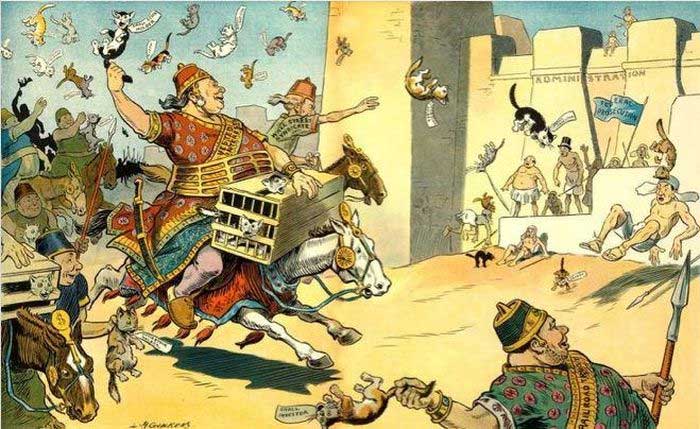Seemingly assured of victory against the Persian forces, the Egyptians suffered a devastating defeat due to cats...
The culture of ancient Egypt placed a profound emphasis on the sanctity of life, viewing it as a gift from the gods. This reverence extended to both humans and animals, reflecting a deep understanding of the interconnectedness of all existence. While the Egyptians occasionally consumed meat, their diet primarily consisted of vegetarian or pescatarian dishes (only eating fish and seafood), highlighting their respect for the sanctity of all life.
In the past, the Persian army exploited this reverence within the culture by using cats as hostages and employing them as a strategic weapon in battle. Aware of the special place that cats held in Egyptian society, the Persians led these animals (along with other creatures) to the front lines of battle and even painted images of cats on their shields.
Three millennia ago, it was because of cats that ancient Egypt suffered defeat in a battle that determined the fate of the nation against the invading Persians. This was the Battle of Pelusium, which took place in 525 BC between the Persian army led by Emperor Cambyses II and the Egyptian forces under Pharaoh Psammetik III (also known as Psammenitus).
The battle was sparked by Cambyses II proposing to marry the daughter of the Egyptian pharaoh at the time, Amasis. Amasis, unwilling to turn his daughter into a political tool, sent the daughter of a previous pharaoh as a substitute. When this scheme was uncovered, Cambyses was furious at being deceived and promptly declared war. By the time he personally led the attack on Egypt, Pharaoh Amasis had passed away and the throne had been passed to Psammenitus.
Psammenitus decided to camp at Pelusium, an important Egyptian city near the Nile Delta, to intercept the Persian forces. Here, the defensive troops successfully repelled multiple waves of Persian attacks. It seemed as though victory was assured, but the Egyptian forces ultimately faced a catastrophic defeat due to the cats.
This stemmed from the fact that the ancient Egyptians venerated Bastet, the goddess depicted as a woman with the head of a cat, symbolizing family, love, and fertility. Often portrayed with a woman’s body and a cat’s head, or sometimes as a majestic sitting cat, Bastet represented various aspects of family life and femininity. She was revered as the goddess of the home, morality, and women’s secrets, symbolizing fertility, childbirth, and maternal protection. Bastet was believed to protect households from evil spirits and diseases, especially those affecting women and children. Her presence was thought to bestow blessings and prosperity upon families, ensuring their happiness and harmony.
Because of Goddess Bastet, the Egyptians held cats in immense reverence. Anyone who killed even a single cat would face the death penalty.

Cambyses II led an attacking force carrying live cats into the Egyptian troops.
Knowing this, Cambyses II ordered the image of the goddess Bastet to be painted on the shields of his soldiers. He even sent an attacking force carrying live cats into the Egyptian ranks. When the Egyptians saw the goddess’s image on the enemy’s shields, they were filled with fear and dared not fight. All of them abandoned their positions and fled when the “cat army” charged toward the city.
The Egyptian soldiers were slaughtered by the enemy, and the corpses piled up to such an extent that Herodotus, the famous historian of ancient Greece, recorded that their bones remained mixed in the desert sands many years later. After the battle, Emperor Cambyses II continued his advance, besieging the city of Memphis. Memphis fell quickly, and Cambyses II captured Psammenitus, asserting control over Egypt.
Although cats held a high status in ancient Egypt, they were not domesticated in the Nile Valley. Instead, the earliest records of domesticated cats come from the Near East, an area known as the Fertile Crescent. It was here that some of the earliest civilizations of humanity emerged.
The first agricultural revolution transformed hunter-gatherers into farmers, who abandoned their nomadic lifestyles. This change coincided with the emergence of new technologies and the first complex societies, as settlements gradually evolved into cities and later into kingdoms and empires. Food surpluses spurred the development of civilization. However, large granaries and stores of precious grain were frequently threatened by a small but persistent enemy—mice and other pests.
It was here that cats approached humans and became an integral part of human history. Attracted by rodents, local wild cats sneaked into the first agricultural villages. Recognizing their value, humans began to treat these cats well, leaving food scraps to encourage them to stay.
Gradually, cats adapted to humans. However, unlike dogs, cats were never fully domesticated. The earliest evidence of cats and humans living together comes from Cyprus, where archaeologists have unearthed the grave of a tabby cat dating back 9,500 years, buried alongside its owner.





















































